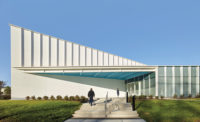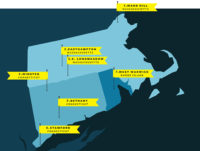Tokyo, Japan
Aquiet collection of aging factories and outdated manufacturing plants, the Keihin industrial district of Tokyo seems light-years away from the city’s eye-popping, neon-clad commercial centers. But against this monochromatic backdrop, the AGC Quality Manufacturing Training Center, designed by Takenaka Corporation, positively glows. During the day, the building’s prominent, bullet-shaped south elevation reads as a series of concrete planes rhythmically interspersed with narrow strips of glass. But at night, when the building is illuminated from within, the masonry recedes and the transparent panels change the four-story structure into a graphic display of the color spectrum.
The center belongs to Japan’s largest glass manufacturer, Asahi Glass Company (AGC), a major supplier to the automotive, architecture, and electronics industries, as well as a producer of glass-related chemicals. Located in different parts of the country, AGC’s various sectors are physically isolated and fairly independent entities. But all of the organization’s companies anticipate the retirement of their highly skilled, baby-boomer workforce in the near future. This pressing reality generated a need for a joint facility where technical know-how could be transmitted to the next generation of employees. In 2005, AGC conducted an invited design competition for a training center on the grounds of its Keihin factory and awarded the commission to the building design department of Takenaka, one of Japan’s five major construction companies.
Linked by a covered walkway and a shared parking lot, Takenaka’s center consists of two parts. One is a 19,736-square-foot, metal-clad volume containing a variety of workshops on three floors. The other is the concrete-skinned, 70,455-square-foot structure designated for conferences and classroom-style learning. Organized around an enclosed courtyard that admits daylight into the middle of the interior, the larger building holds the entrance hall, exhibition area, and a variety of meeting rooms on the ground floor; a practical training room and seminar rooms on the second floor; then two floors of additional seminar and meeting rooms, as well as a lounge and a terrace on the fourth floor.
The no-nonsense plan of the seminar building practically designed itself: Hugging the perimeter walls, the various rooms are strung together by circulation spines running the building’s length. On the other hand, creating a distinct character for this facility required careful consideration. “We needed a concept for expressing the company ideas through the building,” explains Hirotsugu Yamaguchi, manager of Takenaka’s architectural design section. The architects’ solution lay in the relationship between light and glass itself.
Borrowing a concept from physics, the Takenaka team used the spectrograph of glass, or graphic representation of the light waves emitted by glass, as its model for painting and positioning thin bands of 17 different colors on interior corridor walls and ceilings. The rainbow stripes range from dark red to deep purple with selected shades of orange, yellow, green, and blue in between. Each one aligns perfectly with an exterior, 2-foot-wide slit window that extends the height of the south elevation and bends over to become a skylight. Punctuating the long corridors, the painted stripes are concentrated in wall recesses where fluorescent lamps hidden in vertical cove fixtures bounce light off the tinted surfaces, resulting in the brilliant, reflected hues that both animate the interior during the day and brighten up the exterior at night.
In order not to detract from the colored walls, overhead luminaires were omitted from the circulation spaces. But individual room interiors were another matter. Here the designers used ceiling-mounted fluorescent lights made from 1¼2-inch-diameter glass tubes earmarked for convenience-store display cases. While room light is normally one consistent color temperature measured in kelvins, the architects hoped to awaken the senses and improve working conditions by blending lights of different temperatures together. In the lounge, for example, the 15-foot-high ceiling is lined with 100 red, white, blue, and yellow lamps intended to infuse the room with a relaxed atmosphere and to stimulate communication.
“We tried to introduce company products as much as possible,” explains Yamaguchi. Indeed, while the largely opaque south elevation helped keep costs down, the east-facing facade is made entirely of the heat-absorbing sheets that AGC produces as windshields for its carmaker clients. Tinted like privacy glass, the wall comprises 450 3-foot-square panels that effectively block out the early morning sun.
In 1916, when Asahi Glass first opened its factory on this site, Japan was in the throes of rapid Westernization and modernization. Today, AGC is on the brink of another major transition. And with 25,000 people passing through its doors yearly, its training center is doing its share to light the way.



Post a comment to this article
Report Abusive Comment